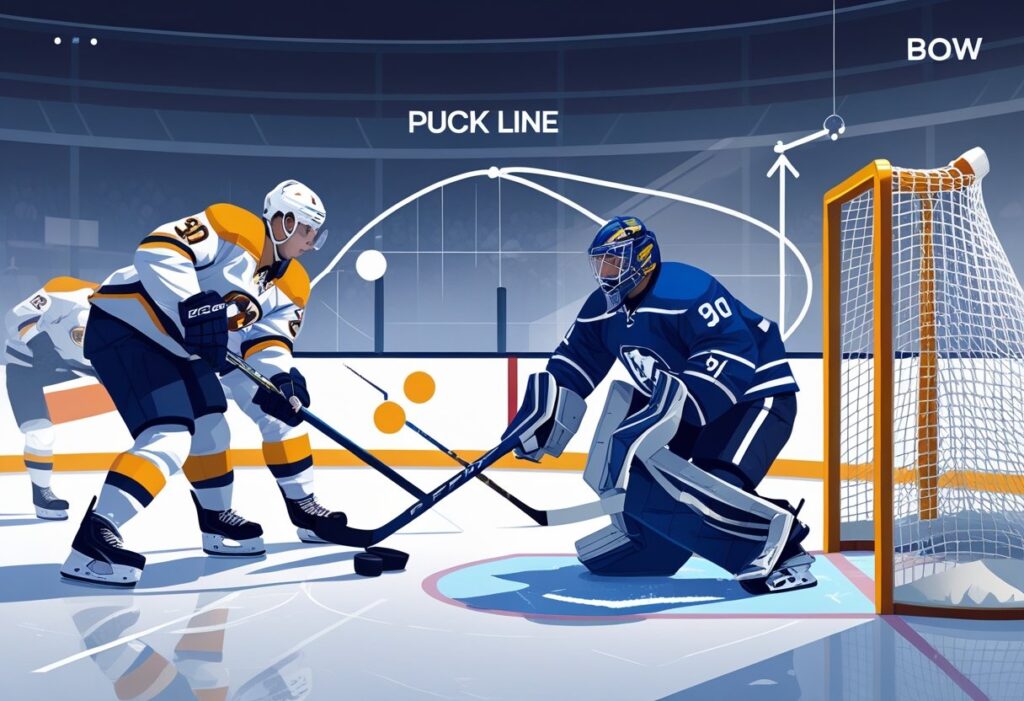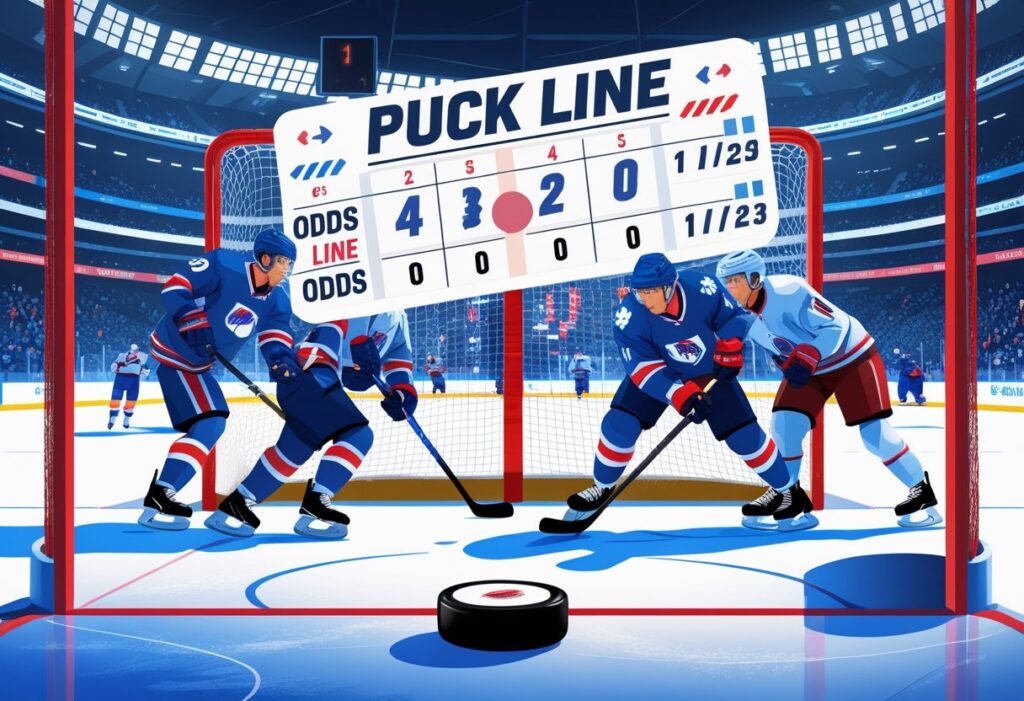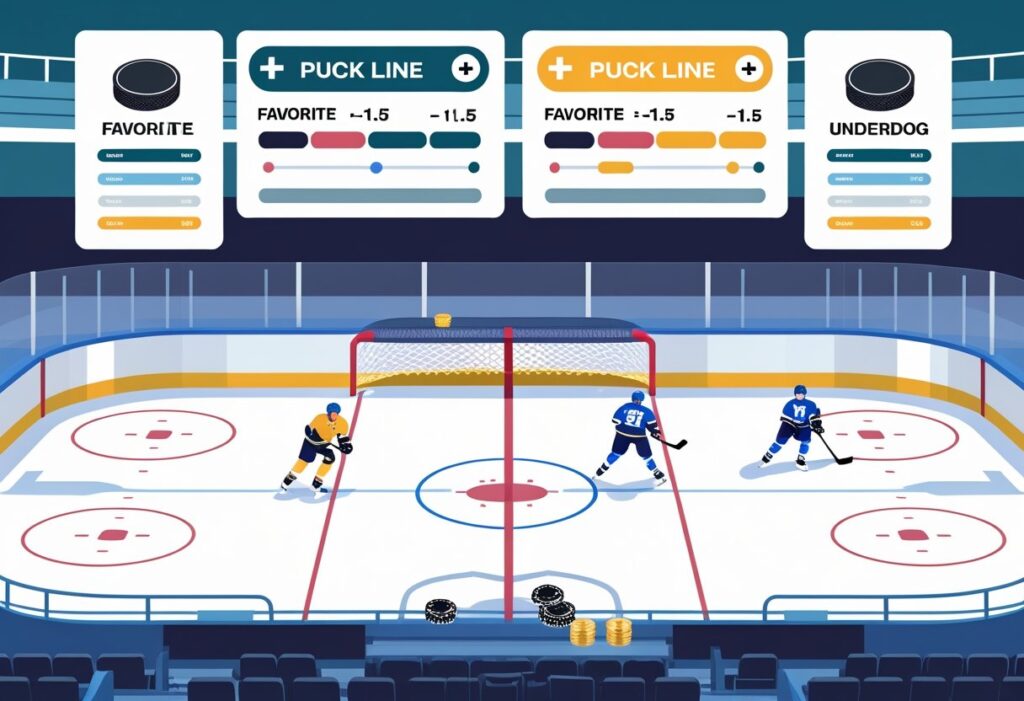by Martin Green
August 9, 2025
Last Updated on August 9, 2025 by Martin Green
If you’ve checked out NHL betting lines, you’ve probably noticed numbers like -1.5 or +1.5 next to each team. The puck line is basically hockey’s version of the point spread – the favorite starts at -1.5 goals, while the underdog gets a +1.5 goal head start. So, if you bet the favorite, they have to win by two or more. If you take the underdog, they can either win outright or just lose by one and you’re still good.

The puck line lets you tweak your risk and reward. Betting the favorite on the puck line usually bumps up your odds compared to the moneyline, but you need a bigger win. Taking the underdog at +1.5 makes it easier to win your bet, though the payout drops a bit.
Puck line betting isn’t just for the whole game. Sportsbooks also offer period puck lines, alternate spreads, and even reverse puck lines. With all these options, you can really dial in your bet based on how you think things will go.

In NHL betting, the puck line uses a fixed goal spread to balance the odds between two teams. It changes what you need to win your bet and can give you either a bigger payout or more protection, depending on your side.
The puck line is hockey’s answer to the point spread you see in other sports.
Almost every NHL game sets the puck line at -1.5 goals for the favorite and +1.5 goals for the underdog.
Since hockey games don’t see a ton of goals, the spread almost never moves off 1.5. Instead, the odds (the moneyline prices) shift depending on how close the matchup looks.
This bet gives you a way to squeeze out a better payout on a favorite or lower your risk if you’re backing the underdog.
The point spread in football or basketball can move all over the place, depending on how lopsided the game is. In hockey, the puck line pretty much stays locked at 1.5 goals.
The run line in baseball works the same way, usually set at 1.5 runs. Both the puck line and run line mess with the odds, not the spread itself.
Here’s a quick breakdown:
| Bet Type | Sport | Typical Spread | Adjusts Odds or Spread? |
|---|---|---|---|
| Point Spread | Football/Basketball | Varies widely | Spread changes |
| Puck Line | NHL Hockey | 1.5 goals | Odds change |
| Run Line | Baseball | 1.5 runs | Odds change |
With the puck line, you’re dealing with a fixed spread, so your risk and reward come from the odds, not the points or goals.
For NHL betting, the standard puck line is always -1.5 / +1.5.
Example:
If the Bruins are -1.5 at -105, you’d risk $105 to win $100, and they have to win by 2+ goals.
If the Jets are +1.5 at -115, you’d risk $115 to win $100, and they can lose by 1 or win outright.
These numbers don’t really change unless you dive into alternate puck lines (like -2.5 or +2.5) for different odds.

When you place a puck line bet, the sportsbook slaps a fixed 1.5-goal spread on the game. It’s not like a straight moneyline bet – the win or loss depends on the margin, which changes your risk and payout. The favorite, the underdog, and that goal cushion all play a part.
The favorite gets a -1.5 goal handicap. They’ve got to win by at least two for your bet to hit.
The underdog starts with a +1.5 goal advantage. It’s like they’re up a goal and a half before the puck even drops.
This setup helps balance out the odds. A heavy favorite might not pay much on the moneyline, but the puck line can boost your return if you think they’ll win big.
If you like the underdog, the puck line feels safer. Even if they lose, as long as it’s by one, you’re still covered.
The goal cushion is that built-in edge or hurdle from the puck line. With +1.5, the underdog can lose by one and your bet still wins.
Here’s how it plays out:
| Team | Puck Line | Final Score | Bet Result |
|---|---|---|---|
| Underdog | +1.5 | 3-4 | Win |
| Favorite | -1.5 | 4-3 | Loss |
So, the underdog can drop the game but still cover because of that cushion.
This changes how you bet. If you expect a tight game, you might grab the underdog on the puck line even if you think they’ll lose.
The margin of victory – how many goals a team wins by – is what matters for puck line bets, not just who wins.
Bet the favorite at -1.5? They’ve got to win by two or more. One goal isn’t enough.
Take the underdog at +1.5? They can:
Hockey games are often close, with a lot ending in a one-goal difference. That’s why the +1.5 puck line gets so much action from bettors looking for a safer shot.
Puck line odds decide how much you win or lose when betting with the goal spread. They move around based on team strength, how people expect the game to go, and where the money’s landing. If you get how odds are set and why they shift, you’ll have a better handle on the risk and payout.
Sportsbooks set the puck line at -1.5 for the favorite and +1.5 for the underdog. The spread almost never moves since hockey scores are usually tight.
The odds you see – the American odds like -120 or +200 – show how the sportsbook sees the matchup. A big favorite gets lower payout odds on -1.5, while the underdog at +1.5 pays less if they’re not expected to keep it close.
For example:
| Team | Puck Line | Odds |
|---|---|---|
| Favorite | -1.5 | +210 |
| Underdog | +1.5 | -250 |
So, a $100 bet on the favorite only pays if they win by two or more, but the payout is more than double your bet.
The moneyline is just a straight-up “who wins?” bet. The puck line adds a spread, which shifts the odds.
If a team’s a heavy favorite, the moneyline might be stingy – like -240, meaning you need to risk $240 to win $100. On the puck line at -1.5, maybe it’s -105, so you only risk $105 to win $100 – but now they have to win by two or more.
For underdogs, the puck line can make things safer. A +200 moneyline dog might be +1.5 at -115. You don’t get the big payout, but your chance of winning goes up if they keep it close.
Puck line odds move when sportsbooks react to betting trends. If too much money lands on one side, they tweak the odds to balance things and limit their risk.
Let’s say everyone’s betting the favorite at -1.5. The odds might drop from +210 to +180, making the payout smaller and maybe nudging bettors toward the underdog.
These odds changes don’t touch the -1.5 or +1.5 spread in standard puck line betting. Only the payout shifts, not the goal margin. That’s different from football, where the spread itself can move.
You’ve got a few different puck line options that change the spread or the odds. These let you dial up or down your risk and reward, depending on your read of the game.
An alternate puck line tweaks the usual -1.5 or +1.5 goal spread, letting you pick a smaller or larger margin. So, you might see -0.5 or +0.5 for a tighter spread, or maybe -2.5 or +2.5 if you want to up the risk.
Sportsbooks shift the odds to match the new spread. If you take a favorite at -2.5, for example, you’ll get a bigger payout if they win by three or more – but yeah, that’s a tough ask.
Alternate lines can help you play it safer, too. If you grab +2.5 for an underdog, they can lose by two and you still win, though your payout won’t be huge.
Honestly, this option comes in handy when you’ve got a hunch about how close (or not) the game will get.
The reverse puck line flips everything around – now the favorite’s at +1.5, or the underdog’s at -1.5.
Odds change a lot with this. Taking a favorite at +1.5 usually pays very little since it’s much easier to win. On the flip side, betting the underdog at -1.5 can pay off big if they somehow win by two or more, but let’s be real, that doesn’t happen often.
People use reverse puck lines when they’re convinced the underdog’s going to surprise everyone, or when they want a super-safe bet on a favorite.
A 3-way puck line throws in a third option: the favorite covers, the underdog covers, or the game lands exactly on the spread.
Say you’ve got a 3-way puck line of -1. You can bet the favorite wins by more than one, the underdog wins or loses by less than one, or the favorite wins by exactly one goal.
There’s no push here – “exact margin” is its own result, and the odds get set for all three outcomes.
Go for a 3-way puck line when you want more specific bets and feel pretty good about predicting the exact margin.
Your puck line approach in NHL games should really depend on the matchup, the odds, and your read on the game. You might use it to chase bigger payouts on favorites, cut risk with underdogs, or spot value in shorter stretches like single periods.
Going with the favorite on the puck line means you’re taking -1.5 goals. They need to win by at least two for you to cash in.
This can give you a better payout than the moneyline, especially when a team’s a heavy favorite. For instance, a team at -240 on the moneyline could be -1.5 at -105, so you don’t have to risk as much.
Some good signs for this bet:
If your favorite usually wins tight, low-scoring games, though, you might want to pass – a one-goal win won’t cut it.
Taking the underdog at +1.5 goals means you win if they pull off the upset or just lose by one. Sure, the payout’s not huge, but your chances go up.
This works well if the underdog’s got a strong defense or a goalie on a hot streak. They can keep things close, even against better squads.
If the favorite’s on a back-to-back or dealing with travel, maybe the underdog can cover even if they don’t win.
Just watch out – sometimes the price for +1.5 is steep, like -200 or worse, so weigh if it’s worth it based on how close you think the game will be.
You can jump in with puck line bets during the game (live betting) or just focus on certain periods. Period puck lines usually sit at -0.5/+0.5.
If you take the favorite for a period, you win if they outscore the other team that period. Back the underdog and you win if they win or tie the period.
Live betting lets you react to what’s actually happening. Maybe a favorite starts slow but keeps generating chances – you might get a better number on -1.5 as the game goes on.
These options let you find value without betting on the whole game, especially if momentum swings or lineups shift mid-game.
Scoring trends, NHL rules, and team styles can really affect how puck line bets go. Certain matchups, late-game situations, and how some teams play can make that -1.5 or +1.5 spread more or less risky.
Most sportsbooks settle puck line bets using the final score after regulation and overtime. If a game goes to OT, it almost always ends with a one-goal margin.
This means a favorite at -1.5 pretty much loses if the game gets to overtime, even if they win in the extra frame.
For example:
| Result Type | Final Score | -1.5 Bet Outcome | +1.5 Bet Outcome |
|---|---|---|---|
| OT Win | 3-2 | Loss | Win |
| Regulation Win (2+ goals) | 4-2 | Win | Loss |
Think about how often each team heads to overtime. Teams that play tight, low-scoring games push more contests past regulation, which helps the +1.5 underdog side.
Consider scoring ability, defensive structure, and goaltending when you’re betting the puck line. Teams with a strong attack and steady defense tend to cover -1.5 more often.
On the other hand, teams that keep things close, even against stronger opponents, give you more value on +1.5 bets.
Keep an eye on:
If you notice two teams usually play one-goal games, the favorite’s puck line risk goes up.
The San Jose Sharks have had years where they couldn’t score much but still kept games tight. Betting them at +1.5 often worked out, especially against average opponents.
Even when their offense sat near the NHL basement, they’d lose a lot of games by just one thanks to decent goaltending.
But against top-tier scoring teams, the Sharks sometimes got blown out, so the -1.5 on the opponent looked better.
If you track a team’s average goal margin and compare it to the league, you’ll get a better sense of whether to back or fade them on the puck line.
Puck line betting in hockey uses a fixed goal spread to balance the odds between two teams. You can back a favorite for better odds or give an underdog a cushion and still win your bet.
Alternate lines are possible, and rules for grading bets sometimes differ by sportsbook.
A money line bet just asks you to pick which team wins. That’s it.
A puck line bet adds a margin of victory or defeat, usually -1.5 for the favorite and +1.5 for the underdog. So the payout and risk both change compared to the money line.
A -2.5 puck line means your favorite needs to win by at least three for you to win.
A +2.5 puck line means the underdog can lose by up to two or win outright and you still get paid. These lines aren’t as common and usually come with bigger swings in payout depending on the risk.
If you take the favorite at -1.5, they’ve got to win by two or more.
If you take the underdog at +1.5, they can win or just lose by one. Same logic for alternate puck lines, just with whatever spread you picked.
Most sportsbooks count goals scored in overtime and shootouts for puck line bets.
If the game goes to a shootout, the winner gets one extra goal for the bet. Still, always check your sportsbook’s rules before betting – you never know when they’ll throw a curveball.
Just check out licensed online sportsbooks or betting apps for the latest NHL puck line odds.
You’ll usually see odds posted with the money line and over/under for each game. Lines can move through the day if there are injuries, goalie changes, or lots of betting action.
The puck line works as hockey’s take on the point spread, but you’ll almost always see it set at 1.5 goals.
Other sports toss around point spreads that jump all over the place, while hockey sticks to a fixed spread because the game just doesn’t rack up many goals. If you’re looking for something different, you’ll probably run into alternate puck lines.